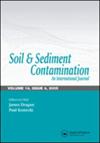Pilot study to determine levels of contamination in indoor dust resulting from contamination of soils
IF 1.5
4区 环境科学与生态学
Q4 ENVIRONMENTAL SCIENCES
引用次数: 12
Abstract
In order to develop more realistic risk assessments, an experimental program was conducted to characterize indoor, residential environments and the relationship between the indoor environment and contaminants that originated from the outdoor environment. Parameters measured included concentration of uranium in soils, mass loading of dust on indoor surfaces, and concentrations of uranium in indoor dust. Samples of indoor dust were collected using a personal air sampler modified to act as a low flow rate vacuum cleaner. The concentrations of uranium in indoor dust were measured using kinetic phosphorescence analysis, while the concentrations of uranium in outdoor soil were measured by analyzing the thorium‐234 activity using gamma‐ray spectrometry. This pilot study derived an estimate of 20 to 30% of indoor contamination resulting from sources in soil.确定由土壤污染引起的室内粉尘污染程度的初步研究
为了制定更现实的风险评估,进行了一项实验计划,以表征室内,住宅环境以及室内环境与室外环境污染物之间的关系。测量的参数包括土壤中铀的浓度,室内表面灰尘的质量负荷,以及室内灰尘中铀的浓度。室内灰尘样本收集使用个人空气采样器改装为低流量真空吸尘器。室内粉尘中的铀浓度采用动态磷光分析测量,室外土壤中的铀浓度采用伽马射线能谱法分析钍- 234活度。这项初步研究估计有20%至30%的室内污染来自土壤污染源。
本文章由计算机程序翻译,如有差异,请以英文原文为准。
求助全文
约1分钟内获得全文
求助全文
来源期刊

Soil & Sediment Contamination
环境科学-环境科学
CiteScore
4.20
自引率
10.00%
发文量
53
审稿时长
2.2 months
期刊介绍:
When it comes to assessing and mitigating contaminated soils and sediments, there is no substitute for having the very latest tools, techniques and methodologies at your fingertips to help you deal with these issues efficiently and cost-effectively.
This is just the kind of essential expertise you’ll only find in Soil and Sediment Contamination . This internationally, peer-reviewed publication focuses on soil and sediment contamination from:
-Sludges-
Petroleum-
Petrochemicals-
Chlorinated hydrocarbons-
Pesticides-
Lead and other heavy metals.
Get detailed descriptions of all the latest and most efficient offsite and in situ remediation techniques, strategies for assessing health effects and hazards, and tips for dealing with everyday regulatory and legal issues. With the state-of-the-art tools that Soil and Sediment Contamination provides, you can successfully assess, mitigate, and solve both rural and urban soil contamination problems as efficiently and economically as possible.
 求助内容:
求助内容: 应助结果提醒方式:
应助结果提醒方式:


